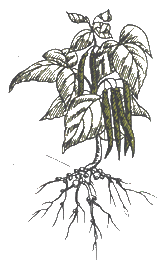by Mike Carter.
Plants, like people and animals, need feeding. Plant nutrients (or foods) such as nitrogen, phosphorus and potassium are needed for the growth and development of crops and trees. Farmers can add more of these nutrients to the soil by using manure, compost or artificial fertilisers.
However, some plant nutrients are present in the soil in a form that the plants cannot use. Nitrogen is present all around the crop in the air. Much of the phosphorus in a soil may be difficult for plants to use. These nutrients are of no use to the plants unless they are first ‘processed’ by tiny micro-organisms in the soil. A single teaspoonful of soil contains millions of micro-organisms like fungi and bacteria. Most of these organisms are helpful to the crop and farmer. Some live together with plant roots in a partnership which benefits both the micro-organism and the crop. Crop yields will be higher when the right micro-organisms are present in the soil. Two examples of these are mycorrhizae and rhizobia.
Mycorrhizae
These can sometimes be seen as white threads amongst the roots of trees and crops. If a soil has been used for growing a crop or tree for many years, then the right mycorrhizae will probably already be present in the soil. But perhaps you want to grow a crop or trees in a soil where it has not grown before - for example, pine trees on a hillside covered with grass.
Include in the soil mix that you use to fill seedling bags or boxes, some soil taken from underneath adult trees of the same type. Here, for example, is a mixture used in Nepal for filling seedling bags before planting pine seeds:
1 part Unsieved pine forest soil with mycorrhizae
3 parts Sieved soil
3 parts Coarse sand
In particular, mycorrhizae help plants take up more phosphorus. They will still grow without the mycorrhizae, but not as fast.
Rhizobia









